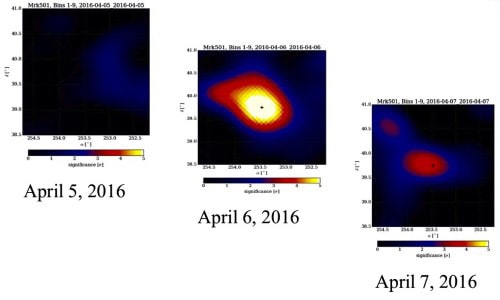
By Hamish Johnston at the APS April Meeting in Salt Lake City
Talk about luck. Just 10 days before the April Meeting the High-Altitude Water Cherenkov (HAWC) gamma-ray observatory lit up with the detection of a galaxy that produced large numbers of teraelectronvolt (TeV) gamma rays for just one day (see image).
Dubbed Markarian 501, HAWC astrophysicists believe that the flare could be driven by a supermassive black hole at the centre of the galaxy. However, they admit that they don’t really understand how such flares occur.
HAWC switched on in March 2015. Other important early results include the highest energy gamma ray detected so far – a whopping 60 TeV. This is four times more energetic than collisions at the Large Hadron Collider at CERN. As a result, HAWC physicists say that their detector could provide important insights into fundamental physics at energies currently inaccessible to collider experiments.
In the past year the observatory has spotted 40 sources of TeV gamma rays, 25% of which are objects that have never been seen before in the TeV spectrum.
HAWC is located high in the mountains in Mexico and last year Physics World‘s Matin Durrani and James Dacey paid a visit. You can read about their exploits in “On top of the volcano” and watch the video below of the HAWC site manager explaining how the observatory works.



